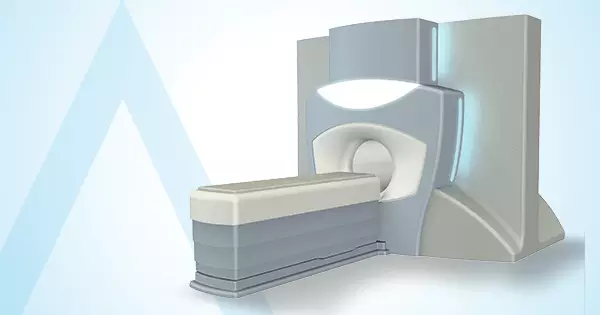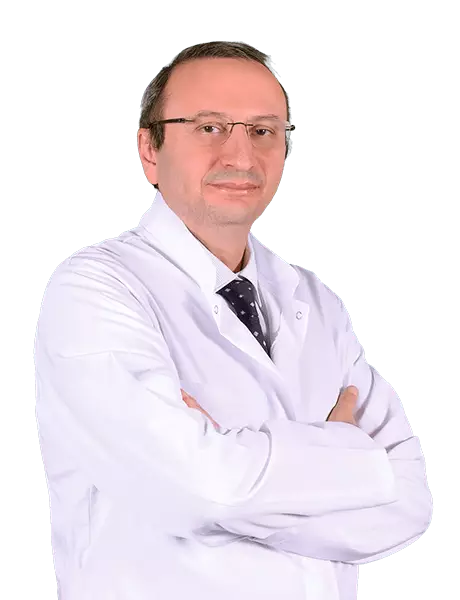Developed by a Swedish neurosurgeon, Gamma Knife is a technology to treat cranial diseases with gamma beams with millimeter accuracy.
The current model of Gamma Knife device, Gamma Knife Icon, is used for treatments at Acıbadem Gamma Knife unit.
How does it work?
Gamma Knife directs the beams originating from hundreds of cobalt sources to a punctual target. Although each source directs low-energy ray bundles, it is possible to transmit very high energy to the target by combining hundreds of rays on a single focus.
It is considered that the effect of Gamma Knife therapy is the result of damage to genetic codes of tumors in brain. This damage follows two different pathways in different brain diseases.
The therapy intends to destroy the rapidly growing tumors and arteriovenous malformations and to stop growth in slowly growing tumors. Diseases of brain can be treated with Gamma Knife along with the diseases that involve bones, vessels, nerves, skin and other tissues around the brain.
Gamma Knife is most commonly preferred for metastases of various cancers to brain, AVMs, metastatic brain tumors as well as benign brain tumors, such as vestibular schwannomas and meningiomas.
Gamma Knife has been installed at more than three hundred facilities and used to treat more than one million patients around the world. It is a standard treatment for intracranial diseases. 7000 patients have been treated at Acıbadem Gamma Knife Unit since 2005.
What are Target Organs for Gamma Knife?
Gamma Knife has been designed and developed for intracranial diseases. Diseases of brain can be treated with Gamma Knife along with the diseases that involve bones, vessels, nerves, eyes, skin and other tissues around the brain.
Different technologies are used to treat diseases that involve other body parts. Gamma Knife has been installed at more than three hundred facilities and used to treat more than one million patients around the world. It is a standard treatment modality for intracranial diseases.
Gamma Knife has been installed at more than three hundred facilities and used to treat more than one million patients around the world. It is a standard treatment modality for intracranial diseases. 7000 patients have been treated at Acıbadem Gamma Knife Unit since 2005.
Gamma Knife technology has been ever increasingly used since 1968 when it was introduced to routine clinical use. Statistics show that more than one million patients have been globally treated with Gamma Knife for various brain diseases.
- Cerebrovascular Diseases
- Arteriovenous malformation (AVM - Abnormal arteriovenous plexus in brain)
- Cavernomas
- Benign Brain Tumors
- Vestibular schwannoma (Acoustic neuroma)
- Hemangioblastoma
- Meningioma
- Chordoma
- Pituitary tumor
- Trigeminal schwannoma
- Tumors of pineal gland
- Craniopharyngioma
- Glomus jugulare tumor
- Malignant Brain Tumors
- Metastases
- Uveal melanoma
- Some glial tumors
- Hemangiopericytoma
- Nasopharyngeal carcinoma
- Patients with Movement Disorders
- Tremor secondary to Parkinson's disease
- Essential tremor
- Patients with Functional Disorder
- Trigeminal neuralgia
- Patients with tumors at hardly accessible and deep locations of brain
- Patient who cannot tolerate surgical procedures due to certain reasons like age, medical condition, general health status
- Patients who refuse open surgery.
Furthermore, Gamma Knife Icon is used for treatment of following diseases.
Brain tumor
Brain tumor is the uncontrolled growth that begins in brain and peripheral tissues at a certain focus. The tissue that grows uncontrollably not only functions improperly, but also causes problems by occupying space in the skull, which is a closed volume.
Treatment of Brain Tumor
The most important step in treatment of brain tumors is to determine the type. Because different types of brain tumors are treated with different treatment techniques or a combination of these methods. The treatment options of all brain tumors are surgery, radiotherapy, chemotherapy or Gamma Knife.
Acromegaly
Acromegaly is caused by benign tumors of pituitary gland that secrete growth hormone, but treatment of the condition is challenging.
For acromegaly, Gamma Knife is an effective treatment to hinder growth of tumor, shrink the tumor and restore hormone values to normal ranges in case of residual tumor after surgery or relapse.
Cerebrovascular Diseases
Cerebrovascular diseases involve the vascular system directly that supplies blood to the brain. Mostly, they are manifested by cerebral crises, called stroke that develops suddenly. They can also cause clinical pictures in the form of a slowly-progressing chronic disease.
Clear determination of the underlying vascular disorder is the first step in treatment of these diseases. Treatment choices vary for different vascular disorders: medication treatment, surgery, endovascular approach or Gamma Knife.
Arteriovenous Malformation
Arteriovenous malformations (abbreviation: AVM) are conditions that are secondary to anomalies, which begin at developmental stage of blood vessels in brain. The disease is characterized by abnormal tangles of blood vessels in various parts of the brain secondary to hypervascularization.
These vascular disorders cause bleeding, epileptic seizures and regional cerebral dysfunctions. They should absolutely be assessed for treatment since they can be life-threatening. Gamma Knife is one of the current effective treatment modalities for AVMs.
Astrocytomas
Astrocytomas are one of the most common tumors that begin in native tissue of brain. There are two types: Pilocytic astrocytoma is a classical example that grows without peripheral invasion. Treatment options for pilocytic astrocytoma are surgery, Gamma Knife, Radiotherapy or Chemotherapy, depending on the patient’s age and location of tumor. However, the group called diffuse astrocytoma grows by invading the normally functioning cerebral tissue and therefore, the only option is a combination treatment.
Intracranial Hemorrhage
Cerebral hemorrhages are manifested by cerebral crises, called stroke that develops suddenly. Although the most common cause of hemorrhages is systemic diseases, such as hypertension, the hemorrhages can be caused by aneurysms that affect the vascular walls or other diseases such as arteriovenous malformations that implies an anomalous vascular structure.
Clear determination of the underlying vascular disorder is the first step in treatment of these diseases. Treatment choices vary for different vascular disorders: medication treatment, surgery, endovascular approach or Gamma Knife.
Brain cancer
Brain tumors are addressed under two titles. Cerebral metastasis is the most common form that implies spread of cancers of other body tissues to brain. On the other hand, a brain tumor begins in and originates from brain tissue and other support tissues (vessels, meninx, etc.). Most common one in adults is glioblastoma that is a rare condition with poor prognosis.
Treatment of Brain Cancer
Treatment of brain cancers is complex and challenging as the disease progresses by invading normally functioning brain tissue and it requires a combination treatment.
Brain Stem Tumor
There are many types of brain stem tumors and they vary greatly depending on patient’s age, their anatomic locations and growth patterns. Surgery, Gamma Knife, Radiotherapy and combination thereof are used for treating these different tumors.
Brain tumor
Brain tumor is the uncontrolled growth that begins in brain and peripheral tissues at a certain focus. The tissue that grows uncontrollably not only functions improperly, but also causes problems by occupying space in the skull, which is a closed volume.
Symptoms of Brain Tumors
Brain tumors manifest in three ways. The most common symptoms are headaches, nausea, vomiting and altered mental status due to increased intracranial pressure. Brain tumors can also cause epileptic episodes.
The third most common symptom is dysfunction in a part of brain that is directly involved by tumor (strength losses, speech disorders, visual impairment, personality changes, etc.).
Types of Brain Tumors
Brain tumors are rare when compared to tumors that begin in other parts of the body. Majority of these tumors are benign. On the other hand, malignant tumors have the worst prognosis among all cancers of human body.
The most common brain tumors are; metastases from cancers that begin in other parts of body, meningeal tumors (meningioma), glial tumors that originate from the native brain tissue, benign tumors of pituitary gland (adenomas) and vestibular schwannomas that begin in vestibular nerve.
Treatment of Brain Tumor
The most important step in treatment of brain tumors is to determine the type. Because different types of brain tumors are treated with different treatment techniques or a combination of these methods.
The treatment options of all brain tumors are surgery, radiotherapy, chemotherapy or Gamma Knife.
Gamma Knife for Treatment of Brain Tumors
Gamma Knife is a medical technology developed to perform low-risk surgical treatment of various diseases of the brain. Tumors are among the most important intended uses of this technology.
Gamma Knife is most commonly used for metastatic brain tumors and benign brain tumors, namely vestibular schwannomas and meningiomas, all around the world.
Radiotherapy in Brain Tumors
Radiotherapy may be used if brain tumors are dispersed in properly functioning brain tissue. Aim of this treatment is to kill tumor cells at the target location, while preserving healthy brain tissue.
While this treatment can be applied to the whole brain, GammaKnife or Stereotactic radiosurgery can also be used, which are significantly focused forms of radiotherapy.
Arteriovenous Malformations in Brain
Arteriovenous malformations (abbreviation: AVM) are conditions that are secondary to anomalies, which begin at developmental stage of blood vessels in brain. The disease is characterized by abnormal tangles of blood vessels in various parts of the brain secondary to hypervascularization.
These vascular disorders of brain cause bleeding, epileptic seizures and regional cerebral dysfunctions. They should absolutely be assessed for treatment since they can be life-threatening. Gamma Knife is one of the current effective treatment modalities for AVMs.
Brain Cancer
Brain tumors are addressed under two titles. Cerebral metastasis is the most common form that implies spread of cancers of other body tissues to brain. On the other hand, a brain tumor begins in and originates from brain tissue and other support tissues (vessels, meninx, etc.).
Most common one in adults is glioblastoma (GBM) that is a rare condition with poor prognosis.
Chondrosarcoma
Chordoma and Chondrosarcoma originate from cartilage tissue and precursors thereof; they grow slowly, but invade the bone.
Treatment of intracranial chordoma and chondrosarcoma is very complex and difficult, as they are located in the cranium and surrounded by very important blood vessels and nerves at the central zone of the skull. Gamma Knife, radiotherapy and particle irradiation (proton beam, carbon ion) are treatment options.
Chordoma
Chordoma and Chondrosarcoma originate from cartilage tissue and precursors thereof; they grow slowly, but invade the bone.
Treatment of intracranial chordoma and chondrosarcoma is very complex and difficult, as they are located in the cranium and surrounded by very important blood vessels and nerves at the central zone of the skull. Gamma Knife, radiotherapy and particle irradiation (proton beam, carbon ion) are treatment options.
Cushing Disease
Cushing disease is caused by cortisone-secreting benign tumors of the pituitary gland. The disease is difficult to treat.
For Cushing Disease, Gamma Knife acts by hindering growth of tumor, shrinking the tumor and restoring hormone values to normal ranges in case of residual tumor after surgery or relapse.
Arteriovenous Malformation
Arteriovenous malformations (abbreviation: AVM) are conditions that are secondary to anomalies, which begin at developmental stage of blood vessels in brain. The disease is characterized by abnormal tangles of blood vessels in various parts of the brain secondary to hypervascularization.
These vascular disorders of brain cause bleeding, epileptic seizures and regional cerebral dysfunctions. They should absolutely be assessed for treatment since they can be life-threatening. Gamma Knife is one of the effective treatment modalities for AVMs.
Balance Nerve Tumor
It is used for vestibular schwannoma, which is a benign tumor that develops on the balance nerve (previously called acoustic neurinoma or Acoustic schwannoma). Growth of tumor can be controlled with Gamma Knife in patients who do not require surgery.
Low Grade Glial Tumor
Low-grade glial tumor is one of the most common tumors that begin in native tissue of brain. There are two types: Pilocytic astrocytoma is a classical example that grows without peripheral invasion. Treatment options for pilocytic astrocytoma are surgery, Gamma Knife, Radiotherapy or Chemotherapy, depending on the patient’s age and location of tumor.
However, the group called diffuse gliomas (astrocytoma or oligodendroglioma) grows by invading the normally functioning cerebral tissue and therefore, the only option is a combination treatment.
Movement disorders
Parkinson’s disease, multiple sclerosis (MS) and traumatic or essential (due to unknown causes, in the elderly) tremors are health conditions with adverse effects on quality of life.
Gamma Knife thalamotomy can be considered in addition to medications for treatment of aforementioned diseases.
Pituitary adenomas (Pituitary Tumor)
Benign tumors originating from pituitary gland, called pituitary adenomas, show clinical symptoms by secreting hormones or compressing the important tissues such as optic nerves. Gamma Knife is a therapeutic option for both hormone-secreting and compressive pituitary adenomas.
Patients followed up at endocrinology department are assessed to determine if they are good candidates for Gamma Knife radiosurgery. Gamma Knife radiosurgery can be used alone or in combination with medical treatment and surgery.
Growth of pituitary tumors can be controlled by 95 to 98 percent with Gamma Knife radiosurgery.
Hearing Nerve Tumor
Nowadays, Gamma Knife is used for vestibular schwannoma, which is a benign tumor that develops on the balance nerve (previously called acoustic neurinoma or Acoustic schwannoma).
Growth of tumor can be controlled with Gamma Knife in patients who do not require surgery.
Benign Brain Tumor
Benign tumors grow slowly over the years. Gamma Knife therapy aims to stop growth in such tumors.
Chondrosarcoma
Chordoma and Chondrosarcoma originate from cartilage tissue and precursors thereof; they grow slowly, but invade the bone.
Treatment of intracranial chordoma and chondrosarcoma is very complex and difficult, as they are located in the cranium and surrounded by very important blood vessels and nerves at the central zone of the skull. Gamma Knife, radiotherapy and particle irradiation (proton beam, carbon ion) are treatment options.
Chordoma
Chordoma and Chondrosarcoma originate from cartilage tissue and precursors thereof; they grow slowly, but invade the bone.
Treatment of intracranial chordoma and chondrosarcoma is very complex and difficult, as they are located in the cranium and surrounded by very important blood vessels and nerves at the central zone of the skull. Gamma Knife, radiotherapy and particle irradiation (proton beam, carbon ion) are treatment options.
Malignant Tumors
Malign tumors have the capability to grow very quickly. Effect of Gamma Knife treatment on these tumors emerges very quickly and can be observed within months. In malignant tumors, Gamma Knife usually destroys the tumor completely.
Arteriovenous Malformations (AVM) also reduce and disappear in a similar way after Gamma Knife therapy, but this effect is slower in AVMs and it appears in a few years.
Meningiomas
Meningiomas are slowly growing tumors that begin in membranes, which surround the brain and the spinal cord, and are mostly benign in nature. Signs and symptoms are secondary to the mass effect.
Treatment of Meningioma
First treatment option is a surgical procedure. However, it may not be possible to remove some meningiomas completely. In some cases, the risk of planned surgery may be high. Gamma Knife radiosurgery becomes a useful option for these cases.
Moreover, this modality can be used for patients with postoperative residue and recurrence. Gamma Knife aims to stop growth of tumor in meningiomas.
In fact, growth of the tumor is stopped in most patients. Gamma Knife radiosurgery stops growth of tumor and reduce the mass lesion in time by 95% in meningiomas.
Oligodendroglioma
Low-grade glial tumor is one of the most common tumors that begin in native tissue of brain. There are two types: Pilocytic astrocytoma is a classical example that grows without peripheral invasion.
Treatment options for pilocytic astrocytoma are surgery, Gamma Knife, Radiotherapy or Chemotherapy, depending on the patient’s age and location of tumor.
However, the group called diffuse gliomas (astrocytoma or oligodendroglioma) grows by invading the normally functioning cerebral tissue and therefore, the only option is a combination treatment.
Pilocytic Astrocytoma
Low-grade glial tumor is one of the most common tumors that begin in native tissue of brain. There are two types: Pilocytic astrocytoma is a classical example that grows without peripheral invasion.
Treatment options for pilocytic astrocytoma are surgery, Gamma Knife, Radiotherapy or Chemotherapy, depending on the patient’s age and location of tumor.
However, the group called diffuse gliomas (astrocytoma or oligodendroglioma) grows by invading the normally functioning cerebral tissue and therefore, the only option is a combination treatment.
Trigeminal Schwannoma
Trigeminal Schwannoma is a benign tumor which begins in trigeminal nerve that is responsible for sensorial innervation of the face.
Trigeminal neuralgia
Trigeminal neuralgia is usually diagnosed after patient complains of pain that is similar to electric shock only in either half of the face. This pain is generally felt in nose, corners of mouth and jaw. Diagnosis is commonly based on patient’s complaints in a physical examination.
Treatment of Trigeminal Neuralgia
Medications are the first-line treatment option. Various surgical interventions may be considered, if symptoms cannot be alleviated. Gamma Knife treatment is also included in surgical options. While the success rate of pain relief is similar with other percutaneous methods, it provides an alternative, especially for elderly patients.
Vestibular Schwannoma (Tumor of the Hearing and Balance Nerve)
Vestibular schwannomas are benign tumors which originate from sheath of vestibulocochlear nerve. It is the fifth most common brain tumor. They are more prevalent in middle- and advanced-age people, but it can be diagnosed in all age ranges.
Patients most commonly present to a clinic with hearing loss and tinnitus. The hearing loss leads to problems such as loss of balance, facial paralysis, and sensorial deficit in face and threatens life of patient by compressing the brain stem.
Treatment of Vestibular Schwannoma
Nowadays, Gamma Knife is used for vestibular schwannoma, which is a benign tumor that develops on the balance nerve (previously called acoustic neurinoma or Acoustic schwannoma).
Growth of tumor can be controlled with Gamma Knife in patients who do not require surgery.
Stereotactic Frame
Mask
Neuroradiology Imaging
After the frame is affixed, an imaging method is selected that best fits the pathology of the patient. Nowadays, MRI is scanned for all patients. In cases of AVM, angiography is performed, while stereotactic frame is affixed. Computerized tomography is also used to plan the treatment in skull base tumors and for the patients with contraindications for an MRI scan.
Dose Planning
Irradiation
After the treatment is planned in a computer, radiation beams are delivered in another part of the device, namely treatment unit. It takes 15 minutes to 1 or 2 hours. Duration of treatment is dictated by volume of tumor and planned dose of radiation.
Gamma Knife Tomography
This tomography modality shows even the smallest movements of the head before and during the treatment. Thus, the target can be irradiated delicately and safely. Moreover, this tomography technique enables use of mask in the treatment.
Patient Monitoring During Treatment
Gamma Knife Icon monitors the application of treatment with tomography and infrared movement sensor. Tomography device locates the skull very precisely in treatments, where a mask or a frame is used, and thus, the intracranial target is identified very clearly. Tomography scan can be repeated during the procedure, if necessary. Moreover, movements of the patient, such as breathing, are continuously tracked by infrared motion sensor.
End of treatment
Gamma Knife is performed in a single session for most patients. Treatment starts in early morning, generally ends in a couple of hours and the patient can be discharged to home. Patients are fit to travel between cities either by plane or highway right after the treatment. Patients continue their daily lives after the treatment.
Hospitals
Services
Doctors
FAQ
-
Does Government Cover Cost of Gamma Knife Therapy?
Yes. The patients with SGK coverage are served at Acıbadem Gamma Knife Unit.
How does Gamma Knife destroy tumor?
It is considered that the effect of Gamma Knife therapy is the result of damage to genetic codes of tumors in brain. This damage follows two different pathways in different brain diseases. The therapy intends to destroy the rapidly growing tumors and arteriovenous malformations and to stop growth in slowly growing tumors.
What kind of effect is expected for malignant tumors?
Malign tumors have the capability to grow very quickly. Effect of Gamma Knife treatment on these tumors emerges very quickly and can be observed within months. In malignant tumors, Gamma Knife usually destroys the tumor completely. Arteriovenous Malformations (AVM) also reduce and disappear in a similar way after Gamma Knife therapy, but this effect is slower in AVMs and it appears in a few years.
What kind of effect is expected for benign tumors?
Benign tumors grow slowly over the years. Gamma Knife therapy aims to stop growth in such tumors.
Can Gamma Knife therapy be used for all tumors?
Although Gamma Knife is an effective treatment, it is not an option for all diseases. You should ask your physician whether your disease can be treated with Gamma Knife or not.
What are side effects that one may experience after Gamma Knife?
The most common side effect of Gamma Knife is headache that can be faced in first several days after therapy. Gamma Knife may affect body tissues in addition to the target depending on many factors, including but not limited to patient, disease and location of disease.
What is Gamma Knife?
Gamma Knife is a technology that uses gamma rays to destroy intracranial diseases with millimeter accuracy. Gamma Knife focuses the beams emitted by hundreds of cobalt sources to a punctual target. Although each source directs low-energy ray bundles, it is possible to transmit very high energy to the target by combining hundreds of rays on a single focus.
What are features of Gamma Knife Icon?
Acıbadem Gamma Knife Unit uses Gamma Knife ICON to serve patients since March 2017. ICON is the youngest-generation Gamma Knife. 1-Its precision is one eight of a millimeter. 2-Sensitivity and safety can be tracked continuously by tomography and infra-red monitoring sensor during treatment. 2-Large lesions can be treated with Gamma Knife Icon, while fractionated treatment is available for patients with large cranial defects. Gamma Knife Icon allows use of a mask or a frame in single- or multi-fraction treatments, while they can be modified or changes according to instant requirements.
What is Gamma Knife therapy?
Gamma Knife is a technology that uses gamma rays to destroy intracranial diseases with millimeter accuracy. Gamma Knife focuses the beams emitted by hundreds of cobalt sources to a punctual target. Although each source directs low-energy ray bundles, it is possible to transmit very high energy to the target by combining hundreds of rays on a single focus.
What are Target Organs for Gamma Knife Icon?
Gamma Knife has been designed and developed for intracranial diseases. Different technologies are used to treat diseases that involve other body parts. Diseases of brain can be treated with Gamma Knife along with the diseases that involve bones, vessels, nerves, skin and other tissues around the brain.
What are indications of Gamma Knife?
Gamma Knife has five major fields of use. These are as follows: benign tumors, malignant tumors, cerebrovascular disorders, functional diseases and intraocular tumors.
Can Gamma Knife therapy be used for all tumors?
Although Gamma Knife is an effective treatment, it is not an option for all diseases. You should ask your physician whether your disease can be treated with Gamma Knife or not.
How was Gamma Knife therapy invented?
Many facilities tried various technologies to decrease the high surgical risks in early 1990s, before World War II. Concepts of “electrosurgery" and “microsurgery” emerged, when electrical and optic technologies started to be used in operating theatres within a short time. Lars Leksell, a Swedish neurosurgeon, developed the stereotactic system that was named after him in 1949. This technology enabled access to the target in brain using a coordinate system. Next, Leksell adapted the radiation beams to this system and invented Gamma Knife in 1963. Thanks to radiation beams, Leksell could achieve a surgical effect at the target located in the skull. Therefore, the technology was named radiosurgery, as is the case with electrosurgery or microsurgery techniques. It was called Gamma Knife, as Gamma beams were used.
How does Gamma Knife destroy tumor?
It is considered that the effect of Gamma Knife therapy is the result of damage to genetic codes of tumors in brain. This damage follows two different pathways in different brain diseases. The therapy intends to destroy the rapidly growing tumors and arteriovenous malformations and to stop growth in slowly growing tumors.
Which surgeons perform Gamma Knife therapy?
Gamma Knife is a surgical device and uses radiation. Therefore, it is used by a team of Neurosurgeons, Radiation Oncologists and Radiation Physicists.
Who are Good Candidates of Gamma Knife therapy?
Although Gamma Knife is an effective treatment, it is not an option for all diseases. You should ask your physician whether your disease can be treated with Gamma Knife or not.
Can a patient with history of brain surgery have Gamma Knife therapy?
Postoperative recurrence is one of the most common conditions that require Gamma Knife therapy. Similarly, Gamma Knife can be considered for tumors that cannot be surgically removed.
Am I appropriate for Gamma Knife therapy?
Although Gamma Knife is an effective treatment, it is not an option for all diseases. You should ask your physician whether your disease can be treated with Gamma Knife or not.
How can I share my MRI results?
You can call Gamma Knife Unit at 0216 649 58 49 or Alo Acıbadem 444 55 44 to request examination regarding Gamma Knife therapy or to send your MRI films and/or reports for follow-up examinations.
Can I contact a physician for Gamma Knife?
Although Gamma Knife is an effective treatment, it is not an option for all diseases. You should ask your physician whether your disease can be treated with Gamma Knife or not. Then, you should necessarily discuss with the doctor who will perform Gamma Knife radiosurgery about how the treatment is performed, aims, success rate, risks, follow-up and prognosis.
How long does Gamma Knife therapy take?
Gamma Knife therapy is a short lasting treatment and it is generally completed within half a day. When patients present for treatment, stereotactic imaging tests are performed and then, treatment is mostly completed within 30 to 60 minutes. The patients can engage in activities of daily life after the therapy.
Is Gamma Knife a single-session procedure?
Gamma Knife is performed in a single session for most patients and it is not repeated. Patients can resume routine daily life after Gamma Knife therapy.
When can I be discharged after Gamma Knife radiosurgery?
Patients can resume routine daily life after Gamma Knife therapy. Wound dressing is not required and convalescence does not apply to this modality. Mostly, medication treatments are not changed. Patients can use flight, voyage or highway to get their home.
How is life of patient affected after Gamma Knife?
Patients can resume routine daily life after Gamma Knife therapy. Wound dressing is not required and convalescence does not apply to this modality. Mostly, medication treatments are not changed. Patients are only asked to present for follow-up visits at certain intervals which are determined depending on characteristics of the disease. MRI is necessarily scanned in follow-up visits.
How much radiation do I expose to in Gamma Knife therapy?
Gamma Knife technology has been developed to protect healthy tissue and minimize exposure of healthy tissue to radiation. The tissues nearby the target are exposed to minimal dose in Gamma Knife therapy. The dose is lower than exposure which a normal individual can be exposed to and it is determined by international radiation safety agencies. Regardless of how safe the treatment is, it is not used for pregnant women and young children, unless it is strictly necessary.
Does government cover cost of Gamma Knife Therapy?
Yes. The patients with SGK coverage are served at Acıbadem Gamma Knife Unit.
Should I have a companion for Gamma Knife therapy?
Companion is a not a must for Gamma Knife therapy. However, patients are encouraged to have a companion.
Can Gamma Knife therapy be considered for children?
Gamma Knife therapy can be used also for children. However, Gamma Knife is performed under anesthesia for children under supervision of anesthesiologists to ensure that they are safe, not afraid and treatment is performed properly and smoothly.
Why are masks used in Gamma Knife Therapy?
Gamma Knife is an extremely precise treatment modality. The patient’s head should remain perfectly still throughout the treatment in order to irradiate the target extremely precisely (one eighth of one millimeter). This standard is fulfilled by a device, called “frame” in Gamma Knife radiosurgery. Success of the frame has been proven in more than 1 million patients. ICON – the youngest-generation Gamma Knife device – enabled use of a mask, in addition to the option of frame, to restrict movements of head.
How are the disease and effect of treatment followed up after Gamma Knife Therapy?
Gamma Knife is performed in a single session for most patients and it is not repeated. Patients can resume routine daily life after Gamma Knife therapy. Wound dressing is not required and convalescence does not apply to this modality. Mostly, medication treatments are not changed. Patients are only asked to present for follow-up visits at certain intervals which are determined depending on characteristics of the disease. MRI is necessarily scanned in follow-up visits.
Does Gamma Knife therapy cause edema in brain?
Cerebral edema after Gamma Knife radiosurgery is a risk, but it is extremely low.
What should be considered following treatment?
Patients can resume routine daily life after Gamma Knife therapy. Wound dressing is not required and convalescence does not apply to this modality. Mostly, medication treatments are not changed. No special treatment-related precaution is instructed.
Does Gamma Knife therapy cause infertility?
Infertility occurs, when sex hormones or reproductive organs are affected or damaged. Other than one exception, Gamma Knife does not affect secretion of sex hormones or reproductive organs. For tumors that begin in pituitary gland, which ensures hormonal communication with other organs of the body, treatments (surgery, radiotherapy or GammaKnife) of tumors may decrease amount of sex hormones. This is a treatable condition.
You should absolutely consult to your physicians, if you are concerned on your disease or infertility.
Can patients with aneurysm receive Gamma Knife therapy?
Gamma Knife is not a viable treatment option to treat aneurysms.
How many sessions are required in Gamma Knife therapy, how often is it given?
Gamma Knife is performed in a single session for most patients and it is not repeated, excluding certain conditions. Also, more than one session may be required for such certain conditions and Gamma Knife allows multi-session treatments.
What should be done before Gamma Knife Therapy?
Gamma Knife therapy does not require preparation. The exception is an 8-hour fasting period before treatment for patients to receive GammaKnife therapy under anesthesia or patients with arteriovenous malformations in brain that require angiography.
Is premedication necessary before Gamma Knife therapy?
Gamma Knife therapy does not require preparation. Patients maintain their current medications for pre-existing diseases at regular doses.
What are the medications to be regularly taken after Gamma Knife therapy?
Patients can resume routine daily life after Gamma Knife therapy. Wound dressing is not required and convalescence does not apply to this modality. Mostly, medication treatments are not changed. No special treatment-related precaution is instructed.
Is a life-long use of medication required after Gamma Knife therapy?
Patients can resume routine daily life after Gamma Knife therapy. Wound dressing is not required and convalescence does not apply to this modality. Mostly, medication treatments are not changed. No special treatment-related precaution is instructed.
What are differences between Gamma Knife and Truebeam?
Gamma Knife is designed and developed as a surgical tool for brain. Success of the Gamma Knife technology paved the way to use radiotherapy technologies for similar purposes and thus, stereotactic radiosurgery (SRS) techniques were invented. While Gamma Knife is solely developed for treatments of intracranial diseases, stereotactic radiosurgery technologies (TruebeamSTX, Cyberknife, Novalis) are designed to treat all organs of the body.
What are differences between CyberKnife and Gamma Knife?
Gamma Knife is designed and developed as a surgical tool for brain. Success of the Gamma Knife technology paved the way to use radiotherapy technologies for similar purposes and thus, stereotactic radiosurgery (SRS) techniques were invented. While Gamma Knife is solely developed for treatments of intracranial diseases, stereotactic radiosurgery technologies (TruebeamSTX, Cyberknife, Novalis) are designed to treat all organs of the body.
Can I fly before or after Gamma Knife therapy?
Patients can resume routine daily life after Gamma Knife therapy. Wound dressing is not required and convalescence does not apply to this modality. Mostly, medication treatments are not changed. Patients can use flight, voyage or highway to get their home.
Are there any diseases contraindicating Gamma Knife therapy?
Pregnancy and medications that lead to bleeding diathesis.
Are patients anesthetized for Gamma Knife therapy?
Anesthesia is not administered in a standard Gamma Knife therapy. Anesthesia induction may be required for children and patients with claustrophobia.
Is Gamma Knife therapy given to claustrophobic patients?
Restrictions for GammaKnife in claustrophobic patients are related to MRI. If patients can tolerate MRI scans, they can receive Gamma Knife therapy. Therapy can be given under supervision of an anesthesiologist for patients who cannot tolerate.
Is relapse possible after Gamma Knife radiosurgery?
Gamma Knife is a punctuate therapy. It has a potent effect on the targeted point or a volume. Although risk of recurrence at the target volume is very low, the disease may, unfortunately, relapse in other body parts or locations.
What are risks related to Gamma Knife therapy?
The most common side effect of Gamma Knife is headache that can be faced in first several days after therapy. Gamma Knife may affect body tissues in addition to the target depending on many factors, including but not limited to patient, disease and location of disease. Its effects on surrounding tissues may be transient or irreversible. Cerebral edema after Gamma Knife radiosurgery is a risk, but it is extremely low. Treatment-related risk of cancer is fairly low in Gamma Knife therapy. A very few patients are reported, although more than one million patients have been treated to date.
Does Gamma Knife damage other parts of brain?
Risk of damage to other parts of brain is low after Gamma Knife radiosurgery.
Will I be paralyzed after Gamma Knife therapy?
Risk of damage to other parts of brain is low after Gamma Knife radiosurgery.
Is there an age limitation for the therapy?
The limitation for Gamma Knife radiosurgery covers first few years of life. Gamma Knife is difficult to apply due to technical reasons for very young patients. Most importantly, benefits of irradiating a developing brain tissue, even if in very small doses, should be very delicately weighed against potential risks.
Do patients require haircut for this treatment?
Scalp hair of patients is not cut for Gamma Knife therapy. Wound dressing is not required and convalescence does not apply to this modality.
What do patients feel during therapy?
Patients do not sense light, heat, sounds, color or any other feeling during Gamma Knife surgery.
What are side effects of Gamma Knife?
Gamma Knife is an overall safer treatment option when compared to other treatment modalities such as surgery, radiotherapy, chemotherapy or others. The most common side effect of Gamma Knife is headache that can be faced in first several days after therapy. Gamma Knife may affect body tissues in addition to the target depending on many factors, including but not limited to patient, disease and location of disease. Its effects on surrounding tissues may be transient or irreversible. Cerebral edema after Gamma Knife radiosurgery is a risk, but it is extremely low. Treatment-related risk of cancer is fairly low in Gamma Knife therapy. A very few patients are reported, although more than one million patients have been treated to date.
What needs to be taken into consideration after the treatment?
Patients can resume routine daily life after Gamma Knife therapy. Wound dressing is not required and convalescence does not apply to this modality. Mostly, medication treatments are not changed. Patients can use flight, voyage or highway to get their home.
Will I irradiate people around me after the therapy?
Effects of Gamma Knife therapy emerge during the therapy. Patients are not radioactive after Gamma Knife.
When does tumor disappear after the treatment?
It depends on type of the disease. It varies from weeks to years. Rapidly growing tumors usually disappear within weeks or months after Gamma Knife radiosurgery.
How about prognosis of disease after Gamma Knife radiosurgery?
Gamma Knife is performed in a single session for most patients and it is not repeated. Patients can resume routine daily life after Gamma Knife therapy. Wound dressing is not required and convalescence does not apply to this modality. Mostly, medication treatments are not changed. Patients are only asked to present for follow-up visits at certain intervals which are determined depending on characteristics of the disease. MRI is necessarily scanned in follow-up visits.
How is the disease followed up after Gamma Knife?
All patients require MRI scans in the follow-up. Although intervals of follow-up visit vary according to the disease, patients present for the first follow-up visit 2 or 3 months after Gamma Knife radiosurgery. This first examination is performed to ensure that the therapeutic process continues smoothly. All MRI scans are repeated and compared to prior tests in this control examination. Next, intervals between follow-up visits are prolonged, but patients are followed up indefinitely. This approach is very critical to ensure safety of our patients.
Do patients residing away from the unit still require follow-up visits after Gamma Knife radiosurgery?
Follow-up visits at regular intervals increase safety of patients significantly. Patients who reside in distant provinces or countries may send their MRI results to our unit and state their status verbally.
How about the daily life of patients and family members after treatment?
Gamma Knife does not require any changes in daily life of patients. Patients may resume usual social life and maintain treatments of other diseases without any changes.
Does Gamma Knife therapy cause edema in brain?
Cerebral edema after Gamma Knife radiosurgery is a risk, but it is extremely low.
What is Stereotactic Radiosurgery (SRS)?
Gamma Knife is designed and developed as a surgical tool for brain. Success of the Gamma Knife technology paved the way to use radiotherapy technologies for similar purposes and thus, stereotactic radiosurgery (SRS) techniques were invented. While Gamma Knife is solely developed for treatments of intracranial diseases, stereotactic radiosurgery technologies (TruebeamSTX, Cyberknife, Novalis) are designed to treat all organs of the body.
Can Gamma Knife be used for benign tumors?
Benign tumors grow slowly over the years. Gamma Knife therapy aims to stop growth in such tumors.
How does Gamma Knife affect benign tumors?
Benign tumors grow slowly over the years. Gamma Knife therapy aims to stop growth in such tumors.
How does Gamma Knife affect benign tumors?
Primary effect on benign tumors is preventing growth of those tumors. Currently, growth of benign brain tumors can be stopped permanently with radiation doses used in Gamma Knife radiosurgery.
Why do not we try to reduce or destroy benign tumors?
Tumors treated with Gamma Knife are located very close to brain tissues, nerves and blood vessels. Most critical aim of Gamma Knife treatment is to preserve brain tissues, nerves and vessels adjacent to tumors to the maximum extent of safety, while growth of tumors is stopped. It is possible to irradiate benign tumors at higher doses to reduce their size, but this approach will lead to risk of damage to critical tissues nearby the tumor. Benign tumors do not threaten life of patients at short-term in most cases; it is overqualified to stop growth of tumors, protect health of patients and prevent occurrence of problems.
How do benign tumors differ from malignant ones?
Benign tumors are broadly characterized by expansion-based growth. They do not infiltrate or invade peripheral tissues. They grow by pushing the peripheral brain tissue and other tissues. Having a clear margin between tumor and healthy tissue makes these benign tumors an ideal target for Gamma Knife.
Which benign tumors can be treated with Gamma Knife?
Most of benign brain tumors are ideal targets for Gamma Knife treatment due their expansion-based growth pattern. Most commonly treated benign tumors are naturally the most common benign tumors. Among the most common ones are meningiomas, vestibular schwannoma and pituitary adenoma.
When is Gamma Knife applied in Meningioma cases?
Meningiomas are generally benign tumors which originate from membranes of the brain (leptomeninx). Meningioma is the most prevalent brain tumor. Its incidence is directly proportional to aging. Surgical removal of meningiomas is the most commonly preferred treatment options for meningiomas with clinical symptoms. However, Gamma Knife is also used commonly in treatment of meningiomas. Gamma Knife radiosurgery is used routinely for: 1. meningiomas which do not significantly compress brain or vascular/neural tissues, 2. Those at critical anatomic locations, where the surgical treatment is risky, 3. For patients who cannot undergo surgery for other medical reasons, 4. Cases with postoperative residual tumor or recurrence.
What does Gamma Knife radiosurgery aim in Meningiomas?
Gamma Knife aims to stop growth of tumor in meningiomas. In fact, growth of the tumor is stopped smoothly in most patients.
How does Gamma Knife radiosurgery conserve critical tissues at the periphery of tumors?
Protection of healthy tissues from radiation exposure has always been the first priority since radiation was introduced to therapeutic use, while the diseased tissues are potently treated. Two different strategies are developed to serve this purpose. In radiotherapy, protection of healthy tissue is ensured by self-regeneration of the tissue. The idea behind radiotherapy technologies is to deliver a dose of radiation which may destroy the tumor over a period of time that enables self-repair of healthy tissues. On the other hand, Gamma Knife technology has been developed to protect healthy tissue and minimize exposure of healthy tissue to radiation.
What is Vestibular Schwannoma?
Vestibular schwannomas are benign tumors which originate from sheath of vestibulocochlear nerve. It is the fifth most common brain tumor. They are more prevalent in middle- and advanced-age people, but it can be diagnosed in all age ranges. Patients most commonly present to a clinic with hearing loss and tinnitus. The hearing loss leads to problems such as loss of balance, facial paralysis, and sensorial deficit in face and threatens life of patient by compressing the brain stem.
What is the role of Gamma Knife in Vestibular Schwannoma?
Today, Gamma Knife is the first treatment option for vestibular schwannoma cases which do not require surgery. Gamma Knife radiosurgery hinders growth of vestibular schwannoma. Although it ensures protection of existing hearing function, this treatment modality can be preferred despite very low risk of facial paralysis. Patients may resume routine daily life after a single-session treatment.
What is the role of Gamma Knife in Treatment of Pituitary Adenoma?
Benign tumors originating from pituitary gland, called pituitary adenomas, show clinical symptoms by secreting hormones or compressing the important tissues such as optic nerves. Gamma Knife is a therapeutic option for both hormone-secreting and compressive pituitary adenomas. Patients followed up at endocrinology department are assessed to determine if they are good candidates for Gamma Knife radiosurgery.
Can Gamma Knife be used for other benign tumors?
Gamma Knife can also be used for treatment of various benign tumors such as; other tumors of cavernous sinus, craniopharyngiomas, hemangioblastomas, pineal tumors, tectal plate gliomas, pilocytic astrocytomas, ependymomas and hemangioblastomas.
Can Gamma Knife be used for malignant tumors?
Most common disease which is treated with Gamma Knife is metastasis. Cerebral metastases of different cancers can be effectively treated with Gamma Knife. However, patients should be assessed in detail before the treatment and Gamma Knife should be verified as the most appropriate treatment for the patient.
Can malignant tumors other than metastases be treated with Gamma Knife?
Many cancer types can be treated with Gamma Knife such as; malignant glial tumors, atypical and malignant meningiomas, hemangiopericytomas, and metastases of nasopharyngeal cancers to brain. Most critical point is that the disease should cover a limited volume and it should a well defined tumor.
Can Gamma Knife be used in treatment of vascular disorders?
Especially congenital disorders of brain vessels and acquired vascular disorders can be treated effectively with Gamma Knife. The highest success rate is observed in Arteriovenous Malformations (AVM), Cavernous Malformations and Arteriovenous Fistulas.
How is Gamma Knife used in AVMs?
AVMs regress gradually over a certain period of time, such as 2 to 3 years, after they are treated with Gamma Knife radiosurgery. Most of the large AVMs may be treated with Gamma Knife.


















